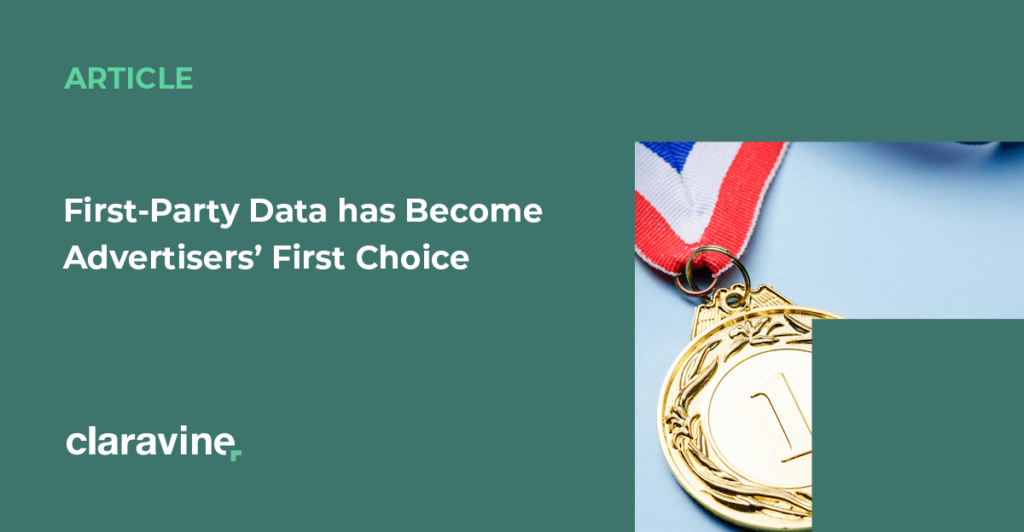Research Shows First-Party Data is Advertisers’ Top Choice for Ad Targeting

Big Brands are Responding to Internet Privacy Changes by Prioritizing First-Party Data, but Many Face Obstacles
Big Tech’s relationship with advertisers is entering a new era, one without the go-to tools of third-party cookies and device-level IDs. Apple has already killed the IDFA, the ID that allows advertisers to track users individually by their device ID, and Google plans to phase out third-party cookies in its market-leading Chrome browser. Combined, these two decisions are tectonic shifts in the $300 billion digital marketing industry.
But do these actions sink brand advertisers who rely on ultra-specific targeting to connect with the right buyers?
Not exactly.
New research from an independent market research firm and commissioned by Claravine, shows that big (and small) brands are already laying out plans to carry on without third-party cookies and device-level IDs. Surprisingly, a bedrock of these plans is a tool that has been a tool that’s been with us for decades already: Collecting first-party data.
Advertisers have long been collecting first-party data like website visits, email clicks, social media conversations, sales transactions, survey data and more. But when big tech powers like Google and Apple started sharing their (much larger) data sets, advertisers began to rely on those more than their own first-party data. With Google and Apple now throttling back the data they share, and no longer allowing advertisers to follow users across the web with browser cookies, advertisers are once again returning to first-party data as their first choice for ad targeting.
To understand how and when advertisers are pivoting, Claravine commissioned an independent research agency to survey 400 marketing and advertising leaders about the path ahead. The margin of error for this study is +/- 4.9% at the 95% confidence level.
A random sample was taken using Lucid, a trusted global sample provider.
Here are a few key insights from our study:
Most advertisers don’t have the right tech to collect first-party data. 83% of advertisers say they will be more reliant on first-party data, but only 38% are sure they have the right technology to categorize their data with metadata
Advertisers need solid data taxonomy to make first-party data work. 53% of advertisers say having a marketing data taxonomy will be vital after Apple and Google’s changes, but only about half of companies currently have one
More budget is being channeled to first-party data collection. First-party data is the new third-party data. 72% of advertisers plan to increase their budgets and staffing to collect first-party data
Growing brands leverage first-party data. Fast-growth brands are over 2x more likely than slow-growth brands to say collecting first-party data will grow in importance after the Google and Apple changes
First-party data is advertisers’ first choice. 86% of advertisers say first-party data will be vital to collect and use going forward
Most advertisers aren’t yet maximizing first-party data. 86% of advertisers say first-party data will be vital, but only 40% are definitely maximizing their first-party data
Growing brands are already funding and staffing for first-party data. Fast-growth brands are 3x more likely than slow-growth brands to say they plan to increase staffing and budgets to collect more first-party data
First-party data is affecting attribution models. The top ways the attribution model will change:
- Reliance on first-party data
- Setting up tracking per channel
- More reliance on social media platform tracking
First-party data collection is among the strategies to see budget boosts. Marketing strategies most likely to see increased budgets due to these changes:
- Brand advertising
- Influencer marketing
- Partnerships
- First-party data collection
- Native apps
Big-budget advertisers are evolving towards more use of first-party data. How big-budget advertisers are evolving after the privacy change:
- More social media marketing
- More email marketing
- More reliance on CRM data
- More first-party data strategies
- Pivot to first-party data for marketing
Agencies are relying more on first-party data. How agencies are changing:
- Increased priority of contextual targeting
- Offering publisher-specific media buys
- Offering targeting and segmentation services<!- – /wp:paragraph –>
- Reliance on first-party data
- Moving to revenue-share models
The research shows that many advertisers see the writing on the wall: Their marketing campaign results will rely once again on the data they collect, organize, analyze, and act on themselves. They can no longer rely on big tech to feed them the user, behavioral, web browsing, and geo-location data they relied on before in the open web.
For now it seems that the rewards of the market will go to the advertisers who adjust to this new reality by becoming their own resource for ad-targeting data, while advertisers that don’t will struggle to connect with new buyers with effective targeting and messaging.





